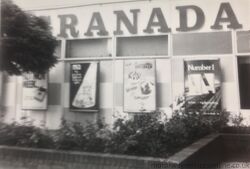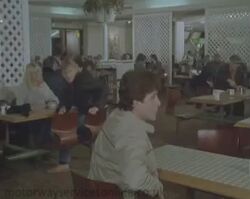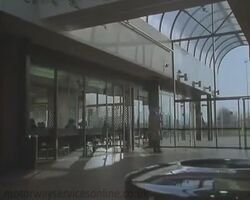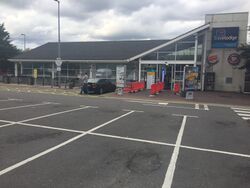History of Heston services

The original eastbound building in 1977.

Heston owes its heritage to a planned maintenance compound at M4 J3, known as the D-Ring junction. The police were keen to ensure that HGVs had somewhere to stop outside of Central London, but the options available for the M4 were "severely limited", so it was decided that the maintenance compound should be combined with a parking area.
Choosing Location
See also: M4 Service Area Planning
The new combined maintenance compound and lorry park was initially going to go in the south-west corner of the junction, and then the feasibility of the north-east quadrant and Church Road were investigated. This plan quickly grew in scale, until it was realised this would be attracting far too much traffic to what was expected to be a very busy interchange.
A 14-acre alternative site was found on the disused Heston Aerodome (which had closed in 1947). Objections were received from Middlesex County Council and Heston & Isleworth Borough Council, which primarily involved the nearby street called Grange Close, a street that had specially been built around the planned site of the M4. Some of its new houses would need to be demolished to make space for the slip roads.
The next service area along, Datchet, had even more objections, so it was agreed to move Heston slightly to the west. This created an area of unused land around the link road to the eastbound rear access. As a result, the contract for the service area stated this area must become a landscaped picnic area, something which the operators had to consider.
As this delay would cause the M4 to be opened before the service area was built, a footbridge was not included in the plan. The westbound side had its slip roads changed to increase the distance from J3, creating a different layout on each side.
Rejected Designs
The contract to design the service area received seven qualifying responses, of varying quality.
Unlike many other service areas which had been designed at the time, the land around here was particularly flat and offered no enticing views. The government were also aware of the close proximity of both London and Heathrow, and reminded applicants that the service area should not be trying to attract local traffic, especially those from high-end Chiswick. They ruled that any facilities above the minimum requirements must be on the eastbound side only, as that side was harder to reach from London. The decision to refuse to build a footbridge would ensure that westbound traffic couldn't use the eastbound facilities.
As this was a fairly urban development, low buildings were requested. The main user was expected to be lorry drivers.
W.H. Turner Properties
This company was known for building houses and industrial units. Their building design, road layout and kitchen set-up were all separately described as "unacceptable" by an expert on each subject. The building design was "unimaginative", but at least the rest area "nice" albeit "unexciting". The financial proposals did not meet expectations. Needless to say, this proposal was not examined in detail.
John Willment Automobiles
John Willment owned garages and petrol stations in south west London. Their financial proposal fell significantly short of the requirements, and when they were informed of this they withdrew. Normally companies who had misread the financial brief would be encouraged to resubmit, but a brief look at John Willment's landscaping and kitchen design caused the Ministry to leave things as they were.
Highway Restaurants Ltd
Highway Restaurants Ltd, 1964
Highway Restaurants was a combined offer from Blue Star (frustrated part-owners of three services) and Trust Houses (who were later taken over by Fortes). They initially submitted a non-qualifying financial bid but quickly corrected this with one which qualified but offered disappointing returns for the Ministry.
Highway Restaurants' experience in catering clearly showed in their plans, with a "very efficient and flexible" kitchen. They proposed one long building at the back of each side, with an entrance at each end. On the ground floor were toilets and a shop. The upper floor would have been furnished with banquette seating and offered 374 seats across two restaurants: a coffee bar/café and a grill/café. The buildings were intended to be light and airy, with natural daylight coming through, and a "warm and comfortable" appeal.
Most interesting was that the westbound slip road onto the M4 would have gone through the middle of the amenity building. They called the slip road layout "simple and direct", although the Ministry went for "confusing and long".
The rest area would have been landscaped with soil dug out to create the rest of the site. It would have had a snack bar which had access from North Hyde Lane.
It was the poor financial offer which really held this proposal back - it came last of the qualifying examples.
Regent Oil
Having had bids for Trowell, Hilton Park and Aust all rejected, Regent tried their hand at Heston.
In this case, their financial offer and traffic flow were "poor", while their buildings "left a lot to be desired". A small 17 foot cafeteria provided both self-help and waitress service catering in one place. The landscaping was at least good, and the Ministry approved of the buildings being at the back of the site.
Esso
Before Esso were to go on to operate Washington by chance, they had their eyes on Heston. At Heston, their financial offer was fantastic - so good, in fact, that the Ministry were concerned Esso would be paying so much rent that they would be running the place at a loss. This was a clever strategy: at the time, the growing motoring industry was often about getting there before your competitors. At a time when major oil companies were only just starting to become well-known, a motorway service station on the way into London would have been good advertising for the Esso brand.
The Ministry were sceptical of Esso's new-found enthusiasm: a few years earlier, Esso had said they weren't interested in any motorway services. Seeing as Esso were now trying to lock themselves into a 50-year commitment to pay a lot of rent for this one, the Ministry were concerned a new board member may demand that Esso makes the site profitable by cutting investment. A few years later, exactly that happened elsewhere.
The buildings offered 712 seats, with the upper level having a central kitchen with a café, on the northbound side, a restaurant and transport café. The entrance foyer had lounge seating, timber walls and a ceiling with slatted wood. There was a takeaway restaurant selling sandwiches, and toilets on each level.
Esso were most proud of their patio and terrace, which was designed to offer "complete physical and mental refreshment". It was a conservatory planted with thick trees, acting as an illuminated glass pyramid. The staircase was "timber and glazed", and covered in plants.
The rest area had a "semi-mobile kiosk".
One interesting party trick was that Esso took time to explain that the whole site was designed so that traffic flow could easily be reversed, if the UK were to start driving on the right.
A third of the site was dedicated to a vehicle repair bay, despite requirements that such facilities provide the bare minimum. The whole setup was described as "unsuitable" and the car parks poor. The Ministry decided not to fall for what they felt was an attempt by Esso to bulldoze their your way into the industry and rejected it, reluctantly.
Fortes
Fortes' financial offer was good, but not the best. Their 600-seat restaurant was too small. It was assumed this was because Fortes had recently-opened the London Airport Hotel, and the Ministry felt that Fortes were hoping this would take the high-end trade while Heston took what was left.
This may have been a clever strategy, but the eventual developer of Heston services would be paying the Ministry of Transport a rent that was based on the site's turnover. Allowing customers to be sent to London Airport was against the Ministry's interest, and the Ministry knew this.
Fortes nearly got the sympathy vote though. They had recently submitted many good designs, which had come second and lost out to another operator. The rumour was Fortes desperately wanted to win this one, and the Ministry took pity on them.
Ross
Still enjoying the success of Leicester Forest East, Ross wanted a go at Heston.
They noted that the views from the services would not be particularly interesting, but still went for a two-storey design to make the most out of it. The building would have been centrally placed, and the westbound one would have been visible from the motorway. There would have been large signs by the motorway to make up for the poor eastbound visibility.
The waitress service restaurant would have played "soft background music" to offer "complete relaxation". The toilets would have had attendants.
On the ground floor would have been toilets and offices, and a simple, self-contained transport café with its own entrance.
Due to the unusual site layout, the eastbound petrol station would have been split into a completely separate commercial and private vehicle filling areas. The rest area would have had shops and toilets.
Ross were furious that they didn't win, believing that the whole process was unfair.
Granada's Winning Bid

The opening of the bids was a year late, as the local authority had been very difficult to get approval from. Ministers wanted it open in time for the motorway in 1965 but this was missed significantly. In their bid, Granada suggested temporary buildings be provided at first, but this idea was rejected, as was the idea of a phased opening.
Granada had won the contract and typically they wanted to build a big service area here, despite the government policy preferring smaller buildings. They argued that a lot of local traffic would be stopping for a meal. Although this suggestion was accepted, they were still told they would have to down-size their plans, to such an extent that the whole building needed to be redesigned. The two amenity buildings were long, low, thin blocks placed close to the road, with a covered entrance area like one would expect from a hotel. They originally wanted 1048 seats across a grill room, waitress café, self-service café, and transport café.
With the westbound site being the larger of the two, it was able to offer a patio area and two grass areas, one of which would eventually become a hotel.
They had won because their financial offer - once you ruled out the ridiculous rivals - was the most promising. The Ministry were reluctant to let a large firm win another contract, they were also concerned by how late Toddington had opened and how difficult Granada had been to work with over it, but they accepted their plans were one of the best and that the result at Toddington had been "a good showing".
Construction
After winning the contract, Granada asked the Ministry's contractors to get the site ready for them to build on as quickly as possible. Meanwhile, they realised the cost of building the service area was going to be £875,000, and not the £600,000 they had forecast (around £14million over £10million in 2025).
Highway Services division, 1966.
As a result, they asked if they could reduce the seating from 1048 to 940 by removing the waitress service restaurant. They had hoped to reduce it to 880. They also moved the transport café upstairs, reduced the size of the toilets and removed the toilets from the picnic area. The first floor was supposed to hang over the ground on a cantilever but this was cut back.
Concern was raised at the Ministry when Granada were three months late when they handed in their final plans for the petrol station and rest area. Next, they asked if their offer to provide a variety of fuel brands could be revoked. Although they had produced final plans for the amenity building, they weren't detailed enough, and kept being amended - including moving the location of the whole building. Finally, they asked for a reduction in their agreed rent because of the delays.
By this point, having witnessed Granada cause chaos at Toddington and Frankley, the Ministry were fed up and minded to take away the contract for Heston. They only held back because they thought it would be difficult to find another operator who would be willing to pick up from this point. Instead, Granada were given six weeks to make some progress, which they did. The site was built by Richard Costain with Sir Alexander Gibb & Partners as consulting engineers.
Opening

Granada had offered to open the transport cafés first, but withdrew this offer after difficulties at Toddington.
The petrol stations opened on 21 February 1967, westbound building on 21 November 1967 and eastbound building on 4 January 1968. The day before the eastbound side opened to the public, a ceremony was held with the then-Miss England Jennifer Lynn Lewis and Joe Brown, in a stunt designed to advertise the service area's proximity to London and to Heathrow.
The large grill restaurant, which was imported from Frankley, soon closed due to low demand from commuters, a struggle which Granada was having at the time. A large coffee shop instead opened here in 1977, and a self-service shop was built here too. The restaurant was a large L-shaped room, part of which was curtained off for lorry drivers. It was brightly decorated with red and white tiling.
Shortly after opening the eastbound service area was described by architects as "disastrous, cramped and desolate". The westbound side fared better, only being called "harsh". Granada were frustrated that the M4 was regularly being closed to fix issues with the Chiswick Flyover, which would render one building at Heston redundant during each closure.
Within a few months of opening there was some talk about other potential uses for Heston, such as a park and ride facility. However, some inspectors remarked that it was doing better than they had expected.
There was an issue with the car park too: it was too tight, and attendants were required to assist. Granada's errors at Heston caused their directors to lose the contract for Scratchwood.
Meanwhile Heston wasn't just the first service area for traffic leaving London - it was the only option available. The M4 was joined up in late 1971, at which point the next service area was Aust in 106 miles, and a bespoke sign warned of this.
By 1972 the M4 had been completed and Leigh Delamere had opened, so the sign was corrected to say 82 miles. It was eventually removed.
Operation

The police post at Heston was transformed into a control room in 1969, the first time the police had been able to control a network of electronic motorway signs from a control room.
Heston split the critics in a 1978 government review: one calling it "rough" and another "the best". In 1977, Egon Ronay rated the services as "poor", saying on closer inspection the bright colours are "scruffy", "dirty" and "mucky", and noting that most people were bringing their own food and eating it in their car. He did at least like that the beef curry was using leftover hamburger meat, which he called "a gem of originality".
In the early hours of 28 May 1981, an electrical fault caused a fire to break out on the roof of the westbound service area. Only 10 customers had to be evacuated as the motorway was already closed for overnight roadworks. The building was destroyed.
It was rebuilt over the following year and officially opened on 17 February 1983. The replacement building used a shiny corridor with an atrium roof and facilities branching off it, instead of the long-room design used on the eastbound side. Once bold and contemporary, now the tiled corridor tends to look cold and isolated from the facilities.
The replacement was praised for its "conservatory-style" building. It had a large workspace, designed to attract passing business people with contemporary perks of the time such as a phone and internet connection. It was built with a single restaurant, with fixed red seats, white truss and artificial plants. Most of the restaurant area is now out of use, as takeaway food has rendered it redundant. Showers were provided for men but not women. A Burger Express was added.
Until the completion of the M25 in 1986, Heston services was regularly at full capacity. Since then, it has become one of the quieter service areas in the UK, as the road is mainly used by commuters.
Heston was used to trial Granada's unusual style of new traffic signs in 1996. Thames Valley Police supposedly approved of their simplicity and effectiveness.
In 1997, a joint letter by Welcome Break and Granada remarked that experience at Heston and Scratchwood had shown that traffic on these roads had little reason to use a motorway service area. At the time both services were predominately serving sit-down food. A study in 1999 calculated that just 4% of passing traffic was stopping at Heston.
In 1998, the forecourts changed from Mobil to BP.
Gates are provided at the start and end of the lengthy slip roads. These appear to be an early motorway feature which has never been removed. This may be related to the frequent closures of the M4 that Granada reported. Also unusual is that the Highways Agency set up a system of road signs to help traffic find its way if the M4 is suddenly closed - no other service area seems to have this.
Eastbound Redevelopment and Former Picnic Area

Heston turned out to be one of the quieter services on the network, and the remaining original building became tired, too large and too expensive to maintain.
In March 1997, planning permission was refused for the redevelopment of Heston eastbound. However, in May 1998, a similar proposal was approved and quickly put into place. This involved the demolition of the eastbound amenity building, turning it into the lorry park, and building new facilities as well as an interconnected Travelodge. The newer amenity building would be easier to manage, and better designed for modern use, with an open-plan dining area that could easily be updated.
One condition was placed on this planning approval, and this was that Granada - who now owned the land outright - must give up the former picnic area. In a S.106 agreement, they were told to remove all the concrete, landscape it, and transfer the land to the council who would turn it into a nature conservation area. The picnic area idea hadn't worked here as it was too quiet and isolated for visitors to feel comfortable. It had been closed off for some time. In 1965, before the service area had even opened, a study found that motorway picnic areas weren't being used. Access is only available by driving down the Rear Access, so it is now technically out-of-bounds to motorway traffic, but plenty of businesses are advertised down there.
According to Hounslow Borough Council's records, Granada offered to transfer the land in 1998, and the council had until 2001 to respond. The council formally accepted the offer in 1999, and prepared their transfer documents. In October 2001, the council reported that the land was still in an unacceptable condition, and they wouldn't be able to take it on until Moto had made good on the S.106 agreement.
At this stage the matter appeared to be totally forgotten. During 2003 there were a number of planning applications made: Chalfont Coaches wanted it for their depot, Moto wanted it for another Travelodge and a developer wanted to build housing on it. The following year Moto supported another attempt to build houses there. These were all rejected by the council's planning department, but no reference was made to the outstanding transfer.
In around 2004, Moto sold the land to New Bharat Coaches, who wanted to turn it into a depot. The new landowner later argued that they had been advised by the council that the council hadn't accepted Granada's offer in 1998, and that it had lapsed. A separate investigation discovered that the land was being used to illegally empty skips, and an order was issued to have the site tidied.
This brought attention back to the failed S.106 agreement, and this issue was re-investigated in 2007. Hounslow Borough Council called the land "an unacceptable eyesore" and resolved to pursue the S.106 agreement. It's not clear what their current policy is, but New Bharat's name was still advertised here as recently as 2018. Aerial photos show that the land was cleared in 2013, and then commercial activity appears to have begun again in 2018.
In less legally contentious matters, a Greggs opened in the forecourt on 30 March 2017. One finally opened in the main building in June 2020, having been delayed by COVID-19 restrictions.